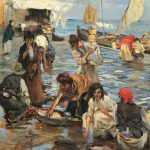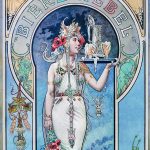Antonio Canova, born on November 1, 1757, in Possagno, Republic of Venice, is celebrated as one of the greatest sculptors of the Neoclassical era. His work, renowned for its beauty and grace, represents a return to classical refinement after the more ornate styles of the Baroque and Rococo periods. Canova’s sculptures are characterized by their delicate treatment of surfaces, serene expressions, and restrained emotion, embodying the Neoclassical ideals of harmony, clarity, and proportion.
Orphaned at a young age, Canova was raised by his grandfather Pasino Canova, a stonecutter of modest renown, who introduced him to the basics of sculpture. Showing early promise, Canova was apprenticed to sculptor Giuseppe Bernardi, also known as Torretto, in Venice. It was under Bernardi’s tutelage that Canova’s talent flourished, absorbing the influences of the Venetian masters and the ancient Roman and Greek sculptures that he studied during visits to the city’s collections.
Canova’s career took a significant turn when he moved to Rome in 1781, where he was exposed to the ruins of antiquity and the works of the Renaissance. Rome’s artistic treasures profoundly impacted Canova, inspiring him to adopt the classical approach that would define his career. His sculptures from this period, such as “Psyche Revived by Cupid’s Kiss” and “The Three Graces,” showcase his ability to capture the idealized beauty and emotional subtlety of his subjects, earning him widespread acclaim and numerous commissions from the European elite, including popes, kings, and Napoleon Bonaparte.
One of Canova’s most notable contributions to art was his revival of lost marble carving techniques, allowing him to achieve remarkable levels of detail and texture. His method involved meticulous work with various tools to create surfaces that mimicked the softness of skin and the fineness of fabrics, enhancing the lifelike quality of his sculptures. Canova’s dedication to the classical ideal did not stop at imitation; he infused his works with a modern sensibility, making them accessible and relevant to his contemporaries.
In addition to his artistic achievements, Canova was also a significant cultural figure in his time. He played a key role in the efforts to repatriate art looted by Napoleon during his campaigns across Europe, demonstrating his commitment to the preservation of cultural heritage. Canova’s influence extended beyond his lifetime, with his studio becoming a center of artistic training and his techniques and approach to sculpture being studied by generations of artists.
Canova’s legacy is not only in the extraordinary beauty of his sculptures but also in his role in defining the Neoclassical aesthetic. His work represents a bridge between the ancient world and the modern, capturing the timeless ideals of beauty and harmony that continue to inspire and captivate. Antonio Canova died on October 13, 1822, in Venice, but his masterpieces, such as “Perseus with the Head of Medusa” and “Venus Victrix,” endure as monuments to his genius, celebrated in museums around the world for their exquisite craftsmanship and ethereal beauty.






